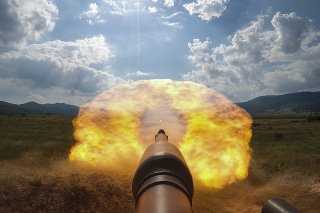Attack! Russia's T-14 Main Battle Tank Was Tested in Syria
Was it a success?
Russian state media reported on Sunday that the Russian Federation Minister of Industry and Trade Denis Manturov announced that his nation’s new T-14 main battle tank (MBT) has been deployed to Syria for testing.
“Yes, that’s right. They [Armata tanks] were used in Syria,” Manturov said in an interview with Nailya Asker-Zade on Deitvuyuschchiye Litas (“Political Actors”), a news and commentary program on Russia’s state-owned Rossiya-1 television channel. “They were used in field conditions, in Syria, so, we took into account all the nuances.”
TASS also reported that Alexander Patapov, CEO of Uravagonzavod, the tank’s developer and manufacturer (incorporated into the Rostec corporation), also said in an early February interview that the Armata T-14 would be supplied to the Russian Army this year for field trials.
If these reports are true, this would mark the first overseas trip for the new next-generation MBT; one of the only such tanks to be in service anywhere in the world. The T-14, which was first demonstrated during the May 2015 Victory Parade in Moscow, is still considered very much a “work in progress,” and as of January, the Russian Ground Forces (RGF) had not taken delivery of its first batch of the tanks.
Its new armor, weapons, munitions and other technology are still being refined. It is considered a significant upgrade from previous Russian tanks. It has a smooth-bore 125mm cannon capable of firing missiles as well as shells up to a distance of 7km; dual explosive reactive armor; an unmanned turret and automatic loader; and next-generation fire control. It has a remote-controlled machine gun, high resolution video cameras to improve situational awareness.
The T-14 has a top speed of 80–90kph and a range of 500km.
Sending the tank to Syria could allow the RGF to determine how well it fares in a “hostile” environment—and Russia has already sent other recently-developed weapons systems, including the Sukhoi Su-34 fighter-bomber and the Kh-101 and Kaliber cruise missiles, to its Middle Eastern ally for field testing.
However, to date Russia has only sent a small number of tank support combat vehicles (BMPT) to Syria, and has not sent any MBTs to the region. This could be more of a show of force than for use in actual combat.
The Drive reported that it is very likely that the Russian military might limit the actual use of the T-14 in order to curtail the potential for accidents as well as actual combat losses. In 2018, the Russian Air Force also sent a pair of pre-production Su-57 to Syria, but then satellite imagery showed that at least one of the aircraft was sitting at Russia’s Khmeimin Air Base surrounded by sandbags to protect it from militant attacks.
Sending the T-14 could be a PR move, one that could suggest the T-14 has been “combat proven.”
It has been noted that while Moscow has touted the Armata as its tank of the future, the cost is too high for it to be the main weapon of Russia’s armored corps. But Russia has made it clear that it would export the tank to help subsidize the production costs. Russia has said it has already received a number of advance orders from foreign buyers.
“Next year, when serial supplies of these tanks to the defense ministry are launched and an exports certificate is obtained, we will begin to work with foreign clients,” said Manturov, who added that a number of countries have expressed interest in the tanks. “Preliminarily, bearing in mind that we cannot provide all the documentation to our foreign clients, well, we do have preliminary orders.”
Peter Suciu is a Michigan-based writer who has contributed to more than four dozen magazines, newspapers and websites. He is the author of several books on military headgear including A Gallery of Military Headdress, which is available on Amazon.com.
Image: Defense.gov

